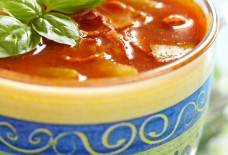These 'Western foods' wouldn't exist if it weren't for the Middle East
By Leyal Khalife
Stepfeed.com
There’s no doubt that Middle Eastern cuisine has become increasingly popular.
Hummus, falafel, shawarma … you name it, they’ve all become widely loved in the West.
But, while some dishes are more known than others, there are many that aren’t recognized as Middle Eastern.
So, dear West, you’re welcome. Because, seriously what’s life without …
1. Ice cream. Yes, it’s Middle Eastern.
Source: Britannica
Summer without ice cream is no summer at all. So, how did it happen?
It all started in 400 BC when Persian engineers mastered the technique of using yakhchals (evaporative coolers) to preserve winter ice for later use, particularly the summer.
At the same time, the Persians popularized a refreshment drink known as the “sharbat”- which was made by mixing fruit syrup (rose water, sugar/honey) and vermicelli.
Using the yakhchals, the Persians then created faloodeh, the traditional Persian frozen dessert, by mixing the drink with snow. It was often served to royalty during hot summer days.
When Arabs conquered the Persian Empire – they took the refreshing drink and added milk and sugar to it – leading to what we now know as gelato.
Ice cream soon made its way into Europe and America after the Muslim invasion of Sicily during the 8th century.
The Arabic word sharibah (to drink) is where the Turkish shorbet actually comes from. It was then adopted by the Italians as sorbetto and later by the French as sorbet.
It eventually made its way into the English language, as sorbet, in the 16th century.
2. It’s not ice cream without an ice cream cone
Source: Webstaurantstore.com
An immigrant from Italy, Italo Marchiony, is often credited with the creation of the ice cream cone, which he was granted a patent for in 1903.
But, it was a Syrian immigrant, Ernest Hamwi, who when forced into finding a quick solution for an ice cream vendor nearby that led to the popularization of the cone in 1904.
During the St. Louis World’s Fair, Hamwi was selling a waffle-like pastry (zalabis) in a booth situated right next to an ice cream vendor.
The vendor soon ran out of dishes and that’s when Hamwi rolled the zalabis in the shape of a cone. He offered it to the ice cream vendor who used it to serve his customers for the rest of the day.
The town soon capitalized on the cone’s success and many business people began introducing special baking equipment for the making of cones.
3. Now for the hot stuff
Source: Storebound.com
When hell freezes over, soup becomes a priority, and this is something Ali ibn Nadi aka Ziryab (Blackbird) knew all too well. The 9th century singer and polymath moved from Iraq to Cordoba where he introduced the concept of a three-course meal to Europe.
He insisted that meals should be served in three separate phases.
It consisted of soup (appetizer), followed by fish/meat (main course) and then fruit and nuts (dessert).
Ziryab is known to have “revolutionized the local cuisine” not only by introducing the three-course-meal we know of today, but for also introducing new fruits and vegetables to the table, including asparagus.
4. It’s not a good morning without a decent cup of joe
Source: LiveScience
Coffee beans originated in Ethiopia, but they started becoming more available after the first export to Yemen.
In fact it was Yemenis who gave it the Arabic name qahwa, which gave rise to both coffee and cafe.
The word qahwa originally meant wine. It was used by Sufi mystics in Yemen as an aid to concentration.
The beverage then spread to Mecca and Medina in Saudi Arabia and later to larger cities in the Arab world including Cairo and Damascus.
During the 16th century, an Ottoman governor in Yemen tried the brew and loved it – introducing it to Sultan Suleiman the Magnificent, popularizing coffee in Istanbul and around the world.
The first “coffee shop” was established in 1555 in Istanbul.
An Ottoman merchant then introduced it to London during the 17th century. Pasqua Rosee, an immigrant from Ottoman Smyrna (Izmir, Turkey), opened the city’s first coffee house named, “The Turks Head.”








